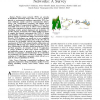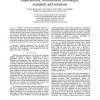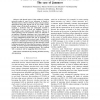114
click to vote
COMSUR
2011
14 years 18 days ago
2011
—Optical layer monitoring and fault localization serves as a critical functional module in the control and management of optical networks. An efficient monitoring scheme aims at ...
122
click to vote
COMSUR
2011
14 years 18 days ago
2011
Abstract—Exchanging cryptographic keys to encrypt the media stream in the Session Initiation Protocol (SIP) has proven difficult. The challenge is to effectively exchange keys w...
135
click to vote
COMSUR
2011
14 years 18 days ago
2011
—Wireless sensor networks (WSNs) are networks of distributed autonomous devices that can sense or monitor physical or environmental conditions cooperatively. WSNs face many chall...
138
click to vote
COMSUR
2011
14 years 18 days ago
2011
Abstract—The Border Gateway Protocol (BGP) is the Internet’s inter-domain routing protocol. One of the major concerns related to BGP is its lack of effective security measures,...
104
click to vote
COMSUR
2011
14 years 18 days ago
2011
— Vehicular networking has significant potential to enable diverse applications associated with traffic safety, traffic efficiency and infotainment. In this survey and tutorial p...
165
click to vote
COMSUR
2011
14 years 18 days ago
2011
Abstract—The computational and memory resources of wireless sensor nodes are typically very limited, as the employed low-energy microcontrollers provide only hardware support for...
144
Voted
COMSUR
2011
14 years 18 days ago
2011
—The shared nature of the medium in wireless networks makes it easy for an adversary to launch a Wireless Denial of Service (WDoS) attack. Recent studies, demonstrate that such a...
132
click to vote
COMSUR
2011
14 years 18 days ago
2011
—This survey guides the reader through the extensive open literature that is covering the family of low-density paritycheck (LDPC) codes and their rateless relatives. In doing so...
124
Voted
COMSUR
2011
14 years 18 days ago
2011
Interference is an unavoidable property of the wireless communication medium and, in sensor networks, such interference is exacerbated due to the energy-starved nature of the netw...
144
click to vote
COMSUR
2011
14 years 18 days ago
2011
Sensor networks with battery-powered nodes can seldom simultaneously meet the design goals of lifetime, cost, sensing reliability and sensing and transmission coverage. Energy-har...




